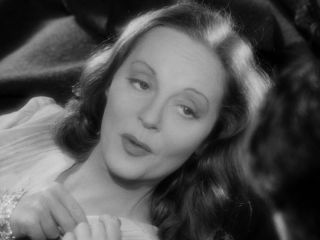The MacGuffin: News and Comment (19/Apr/2008)
(c) Ken Mogg (2008)
April 19
This week I both read J.B. Priestley's novel 'Benighted' (1927) and played Dr Drew Casper's DVD commentary on Hitchcock's film Lifeboat (1944). It's interesting that Dr Casper speaks of the characters in Lifeboat as going through a dark night of the soul, something which is not the only similarity to Priestley's novel. (The latter of course was zestfully filmed in Hollywood by James Whale in 1932 as The Old Dark House from a screenplay by Hitchcock's friend Benn W. Levy.) Priestley stated that the characters who seek shelter in the house of the sinister Femm family one stormy night are representative of post-War 'types' in Britain, while the Femms themselves are collectively like an oppressive force which may destroy the visitors if they don't take stock of themselves and combine their resources to survive the night. (Significantly a central scene in the novel involves a game of 'Truth'. And one of the visitors, a decent but alienated young man named Penderel, is in fact fated to die that night.) It's fair to say that Lifeboat, adapted from an original story by John Steinbeck of some 40,000 words, belongs to a type of allegorical tale about a group of characters which already had literary precedents like the Priestley story and which Steinbeck himself would later write, such as his novel 'The Wayward Bus' (1947), set on the back roads of California. (In a 1983 book 'Steinbeck and Film', Joseph R. Millichap comments: 'Steinbeck intended "The Wayward Bus" to be a big book, his most important since "The Grapes of Wrath". Like the earlier novel it utilized the journey motif and it centred on a symbolic vehicle much like that in Lifeboat.' - p. 107) Incidentally, among the representative characters in 'Benighted' is a rich industrialist named Porterhouse (played in Whale's film by Charles Laughton); in Lifeboat there's a rich industrialist named Rittenhouse (Henry Hull) - though in Steinbeck's original story he was called Brennan. Steinbeck's story differed from the eventual film in many ways. For example, it was told from the first-person viewpoint of Bud, a young merchant seaman, who comments on the other characters and talks about his life in the Merchant Marine. In Hitchcock's film, scripted by Jo Swerling, Bud has become Gus (Wiliam Bendix), fated to die before the end. The most important character change from the Steinbeck story is in the character of the rescued Nazi seaman, who has acquired the name Willi (Walter Slezak) and been given the rank of Captain, as well as being made by Hitchcock and Swerling into a virtual Übermensch figure. Okay, here are some more of my findings about Lifeboat. Firstly, Dr Casper's DVD commentary reminded me that the film's Constance Porter, known as Connie (Tallulah Bankhead), was modelled on US writer and newspaper columnist Dorothy Thompson. This is ironic, given that the real Dorothy Thompson notoriously hated the film, and gave it ten days to get out of town. Born in 1894 in New York, Thompson began her career as a foreign correspondent, gaining recognition in 1921 when she managed to interview Empress Zita of Austria. She reported on the rise of Nazism in Europe in the 1930s, and became the first foreign correspondent to be expelled by Hitler (1934). She began writing a column for the 'New York Herald Tribune' in 1936, and continued her anti-fascist writings, speeches, and broadcasts, for which she is perhaps best remembered. She died in 1961. Lifeboat 'was the first one-set motion picture in the history of the medium' (notes Lee Israel in his 1972 biography 'Miss Tallulah Bankhead'). Nonetheless, an earlier film in which a woman is adrift in a lifeboat filled with men (but only for one sequence) was Frank Borzage's allegorical film Strange Cargo (1940), starring Joan Crawford. I was reminded of this by a passage in a true-life account of such a situation, Elizabeth Fowler's 'Standing Room Only' (1944) - an account which Jo Swerling and Hitchcock almost certainly drew on to provide important details for their film. At one moment in Fowler's book, which she narrates at first-hand, she notes how Crawford's 'torn dress had been swathed about her body with all the allure of a sarong. Her hair had been a shining halo.' In originally remembering this, Fowler 'had an irresistible desire to laugh' for at the time she had been 'oil-covered, disheveled, my hair hanging like dank seaweed over my eyes'. Lifeboat does its best to steer a course between realism and acceptable licence with details. Cleverly, it 'explains' Connie's relative lack of dishevelment by her initial extreme vanity about her appearance. Still, it does have some Joan Crawford-like moments involving Connie's hair. As I've noted here previously, a whole motif of the film involves hair, both Connie's and also that of the Red Cross nurse Alice Mackenzie (Mary Anderson) with whom the wireless operator Stanley Garrett (Hume Cronyn) starts to fall in love. A passage in the film's script which didn't survive into the film has Willi quoting Freud: when Stanley lets down Alice's hair, he is making love to her! (Meanwhile, we may surmise that the glowing shots of Constance with her hair down are a sign of her deepening feelings for the oiler Kovac (John Hodiak). See frame-capture below.)
This material is copyright of Ken Mogg and the Hitchcock Scholars/'MacGuffin' website (home page) and is archived with the permission of the copyright holder. |

